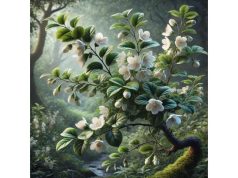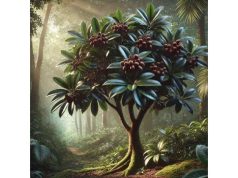
Eastern Cottonwood is a majestic tree native to North America, renowned for its fast growth, impressive stature, and versatile applications. With its broad, deltoid leaves and distinctive cotton-like seeds, this tree has been an integral part of traditional medicine, ecological restoration, and even modern industries. Valued not only for its timber and ornamental appeal but also for its therapeutic properties, Eastern Cottonwood offers a range of health benefits—from promoting respiratory health to supporting skin regeneration and overall vitality. Contemporary research continues to uncover its rich phytochemical profile, validating many of its traditional uses and paving the way for new applications in natural wellness and sustainable resource management.
- Promotes respiratory health and supports lung function
- Provides natural antioxidants and anti-inflammatory compounds
- Aids in skin regeneration and wound healing
- Contributes to overall vitality and stress reduction
- Offers sustainable timber and ecological benefits
- Supports immune function and circulatory health
- Has applications in traditional medicine and modern natural therapies
Table of Contents
- Eastern Cottonwood Botanical Profile and Key Characteristics
- Eastern Cottonwood Historical Legacy and Cultural Significance
- Eastern Cottonwood Phytochemical Profile and Active Constituents
- Eastern Cottonwood Health Benefits and Therapeutic Properties
- Eastern Cottonwood Uses, Applications, and Safety Considerations
- Eastern Cottonwood Research and Recent Study Insights
- Eastern Cottonwood Frequently Asked Questions (FAQ)
Eastern Cottonwood Botanical Profile and Key Characteristics
Eastern Cottonwood (Populus deltoides subsp. monilifera) is one of North America’s most iconic and widespread trees. Belonging to the Salicaceae family, it is closely related to other poplars and aspens, yet it stands out due to its immense size, rapid growth, and distinctive morphological features.
Morphology and Growth Habit
Eastern Cottonwood is a tall, robust tree that can reach heights of 30–40 meters, with a broad, spreading crown that provides ample shade. The trunk is often massive and deeply furrowed, with a grayish-brown bark that becomes increasingly rugged with age. Its leaves are large, triangular to heart-shaped, and are characterized by a coarsely toothed margin. In the spring and summer, these leaves are a bright green, turning golden-yellow in the fall before they drop. One of the most striking features of Eastern Cottonwood is its prolific production of cotton-like seeds. These seeds are attached to silky strands that flutter in the wind, aiding in wide dispersal and rapid colonization of new areas.
Habitat and Distribution
Native to the central and eastern regions of North America, Eastern Cottonwood thrives in riparian zones, floodplains, and other areas with ample water supply. Its preference for moist, well-drained soils makes it a common sight along riverbanks and streams. The tree’s robust root system not only stabilizes soil but also helps it to access deep water reserves, which is essential for survival in regions with variable precipitation. Its ability to tolerate flooding, along with its rapid growth rate, makes Eastern Cottonwood an ideal pioneer species in disturbed sites, where it helps to restore ecological balance.
Ecological Role and Adaptations
The ecological importance of Eastern Cottonwood cannot be overstated. It provides critical habitat for numerous bird species, mammals, and insects. The dense canopy offers shelter, while the seeds serve as a food source for a variety of wildlife. Moreover, the tree’s rapid growth contributes to effective carbon sequestration, playing a role in mitigating climate change. Its extensive root network stabilizes riverbanks and prevents erosion, which is vital for maintaining water quality and preventing sedimentation in aquatic ecosystems.
Cultivation and Genetic Diversity
Eastern Cottonwood is highly valued in both natural forestry and urban landscaping. Its fast growth and adaptability have made it a popular choice for reforestation projects and erosion control initiatives. Over time, various cultivars have been developed through both natural selection and selective breeding, resulting in trees with enhanced growth characteristics and improved resistance to pests and diseases. Research into the genetic diversity of Eastern Cottonwood is ongoing, as scientists seek to preserve its natural resilience and improve its utility in sustainable forestry practices.
The robust botanical profile of Eastern Cottonwood, characterized by its impressive stature, adaptive growth habits, and crucial ecological functions, makes it a cornerstone of North American ecosystems. Its physical attributes and adaptability not only contribute to its survival in challenging environments but also underscore its value as a resource for both ecological restoration and commercial use.
Eastern Cottonwood Historical Legacy and Cultural Significance
Eastern Cottonwood has played a vital role in human history, influencing cultural practices, economic development, and traditional medicine across North America. Its legacy is intertwined with the lives of Native American tribes, early settlers, and modern communities who have relied on its many resources.
Traditional Uses and Native American Heritage
For centuries, Native American tribes have revered Eastern Cottonwood for its practical and medicinal properties. The bark, leaves, and sap were used in various traditional remedies to treat ailments such as fever, pain, and inflammation. The presence of natural salicylates in the bark, similar to the active ingredient in aspirin, made it a valuable resource for alleviating headaches and reducing fever. Additionally, parts of the tree were used in ceremonial practices, symbolizing strength and resilience. The cultural significance of Eastern Cottonwood in Native American traditions is reflected in the many legends and stories that celebrate its role as a protector and provider.
Impact on Early Settlers and Economic Development
During the early years of European settlement in North America, Eastern Cottonwood quickly became an essential resource for frontier communities. The tree’s rapid growth and abundant wood made it a primary source of timber for building homes, barns, and other structures. Its lightweight, yet sturdy, wood was also used in the production of furniture, paper, and other manufactured goods. The cotton-like seeds and fluffy fibers, often seen floating in the wind, became emblematic of the natural beauty of the American landscape. The economic importance of Eastern Cottonwood during this period cannot be underestimated, as it contributed significantly to the growth of rural economies and the development of local industries.
Cultural Symbolism and Modern Significance
In contemporary times, Eastern Cottonwood continues to hold cultural and symbolic value. It is often celebrated in literature, art, and community events as a symbol of natural beauty, resilience, and the enduring connection between people and the land. Urban planners and landscape architects incorporate Eastern Cottonwood into cityscapes for its aesthetic appeal and environmental benefits. The tree’s ability to sequester carbon, improve air quality, and provide shade has made it a favored choice in sustainable urban design. Moreover, Eastern Cottonwood is frequently featured in environmental education programs, highlighting its role in ecosystem restoration and conservation.
Preservation and Community Initiatives
Efforts to preserve and promote Eastern Cottonwood have gained momentum in recent decades. Community-based initiatives, reforestation projects, and conservation programs aim to protect the remaining stands of this important tree species while promoting sustainable forestry practices. Educational programs that emphasize the historical and ecological significance of Eastern Cottonwood help to raise public awareness and encourage community engagement in environmental stewardship.
The historical legacy and cultural significance of Eastern Cottonwood reveal a deep and enduring relationship between this remarkable tree and the people who have depended on it for generations. Its multifaceted role in traditional medicine, economic development, and cultural symbolism continues to resonate in modern society, reinforcing its status as an icon of natural heritage and human resilience.
Eastern Cottonwood Phytochemical Profile and Active Constituents
The therapeutic properties of Eastern Cottonwood are supported by a diverse array of bioactive compounds present in its bark, leaves, and sap. Modern scientific research has begun to unlock the phytochemical secrets of this tree, providing a biochemical basis for its long-standing use in traditional medicine.
Salicylates and Pain-Relieving Compounds
One of the most significant discoveries in Eastern Cottonwood’s phytochemical profile is the presence of natural salicylates in its bark. Salicin, a compound that serves as a natural precursor to aspirin, has been traditionally used by Native American healers to alleviate pain and reduce fever. This analgesic and antipyretic property underpins many of the tree’s medicinal applications, making it a natural remedy for headaches, muscle pain, and inflammatory conditions.
Flavonoids and Polyphenols
Eastern Cottonwood is also rich in flavonoids and polyphenols, which are renowned for their antioxidant properties. These compounds play a crucial role in scavenging free radicals and reducing oxidative stress, thereby protecting cells from damage. Flavonoids such as quercetin and kaempferol, along with a host of other polyphenolic compounds, contribute to the tree’s anti-inflammatory and cardioprotective effects. The synergistic action of these antioxidants helps to support the immune system and may reduce the risk of chronic diseases, including cardiovascular disorders and certain cancers.
Tannins and Astringent Properties
The bark of Eastern Cottonwood contains tannins, which are known for their astringent properties. Tannins help in tightening tissues and reducing inflammation, making them useful in the treatment of wounds and skin irritations. Traditional applications often involved the use of cottonwood bark poultices to cleanse and heal minor cuts, abrasions, and ulcers. The astringent effect of tannins also contributes to improved digestion by reducing gastrointestinal irritation.
Essential Oils and Volatile Components
Though not as prominent as in some aromatic herbs, the leaves of Eastern Cottonwood do contain trace amounts of essential oils. These volatile compounds add to the overall therapeutic profile of the tree by providing mild antimicrobial effects and contributing to its distinctive aroma. While the essential oil content is relatively low compared to other medicinal plants, it nonetheless complements the tree’s anti-inflammatory and antioxidant activities.
Extraction and Standardization
Modern extraction techniques, such as solvent extraction and steam distillation, have been employed to isolate and concentrate the bioactive compounds from Eastern Cottonwood. Standardization of these extracts is crucial to ensure consistency in potency and quality, especially when used in clinical research and commercial herbal formulations. Ongoing research aims to optimize extraction processes to maximize the yield of salicin, flavonoids, and other beneficial compounds while preserving their natural integrity.
The comprehensive phytochemical profile of Eastern Cottonwood not only validates its traditional use as a natural remedy but also provides a solid foundation for its potential applications in modern medicine. The combination of salicylates, flavonoids, tannins, and other bioactive constituents underpins the tree’s wide-ranging health benefits and highlights its importance as a medicinal resource.
Eastern Cottonwood Health Benefits and Therapeutic Properties
Eastern Cottonwood has been esteemed in traditional medicine for its extensive health benefits, many of which are now supported by contemporary scientific research. The bioactive compounds present in the tree contribute to a range of therapeutic properties that promote overall health and well-being.
Pain Relief and Anti-Inflammatory Effects
One of the primary benefits of Eastern Cottonwood is its natural pain-relieving capacity. The salicin content in the bark acts as a natural analgesic, similar to aspirin, helping to reduce pain and inflammation associated with headaches, muscle soreness, and arthritis. The anti-inflammatory properties of the flavonoids and polyphenols further enhance this effect by reducing inflammatory markers and mitigating tissue damage. This dual action makes Eastern Cottonwood an attractive option for individuals seeking natural alternatives for pain management.
Digestive Support and Gastrointestinal Health
Traditional healers have long used Eastern Cottonwood to address various digestive disorders. Its tannins and other astringent compounds help to soothe the gastrointestinal lining, reduce irritation, and promote the healing of ulcers. By enhancing digestion and reducing inflammation in the gut, the tree’s extracts can alleviate symptoms such as diarrhea, bloating, and indigestion. Regular consumption of standardized extracts or teas made from Eastern Cottonwood may support overall digestive health and contribute to a balanced gut microbiome.
Cardiovascular and Metabolic Benefits
The antioxidant properties of Eastern Cottonwood’s flavonoids play a significant role in protecting the cardiovascular system. By neutralizing free radicals and reducing oxidative stress, these compounds help maintain healthy blood vessels and may lower the risk of atherosclerosis. Additionally, some studies suggest that the bioactive constituents in the tree can aid in regulating blood sugar levels and improving lipid profiles, making Eastern Cottonwood a potential natural adjunct in the management of metabolic disorders such as diabetes and hyperlipidemia.
Immune System Support
The diverse range of bioactive compounds in Eastern Cottonwood, particularly its polyphenols and salicylates, also contributes to enhanced immune function. These compounds help to modulate immune responses and provide a protective effect against infections. By reducing inflammation and oxidative stress, Eastern Cottonwood supports the body’s natural defense mechanisms, thereby contributing to overall resilience and health.
Skin Healing and Topical Applications
Topically, Eastern Cottonwood extracts have been used to promote skin health and accelerate the healing of minor wounds. The antimicrobial and astringent properties of tannins help to cleanse and tighten the skin, while the anti-inflammatory effects reduce redness and irritation. Natural formulations incorporating cottonwood extracts are increasingly popular in traditional skincare and wound care, offering a gentle yet effective alternative to synthetic products.
Holistic Health and Overall Well-Being
When used as part of an integrated health regimen, Eastern Cottonwood can contribute to overall well-being by addressing multiple physiological systems simultaneously. Its ability to provide pain relief, support digestive and cardiovascular health, boost the immune system, and promote skin regeneration makes it a valuable component of holistic and natural health practices. The synergy among its various bioactive compounds ensures that the benefits extend beyond individual symptoms to support a comprehensive state of health.
In summary, the health benefits of Eastern Cottonwood are broad and well-supported by both traditional knowledge and modern research. Its multifaceted therapeutic properties make it a promising natural remedy for a wide array of health conditions, reinforcing its importance as a component of integrative medicine.
Eastern Cottonwood Uses, Applications, and Safety Considerations
Eastern Cottonwood is utilized in diverse applications ranging from traditional herbal remedies to modern industrial products. Its versatility and natural properties have made it an indispensable resource in various fields, including medicine, environmental management, and commercial manufacturing.
Traditional and Modern Herbal Uses
Historically, Eastern Cottonwood has been a staple in traditional medicine. Native American tribes and early settlers used decoctions and infusions prepared from the bark and leaves to treat pain, fever, and inflammatory conditions. Today, these traditional remedies are being refined and standardized for use in herbal supplements and natural health products. Common forms of administration include:
- Herbal Teas and Decoctions: Prepared by boiling the bark or leaves to extract the medicinal compounds.
- Tinctures and Liquid Extracts: Concentrated solutions that offer quick absorption and potent effects.
- Powdered Supplements: Dried and ground material used in capsules or added to smoothies for convenient consumption.
- Topical Applications: Creams, ointments, and poultices formulated with Eastern Cottonwood extracts for skin healing and anti-inflammatory benefits.
Environmental and Industrial Applications
Beyond its medicinal uses, Eastern Cottonwood plays a significant role in environmental management. Its rapid growth and extensive root system make it ideal for reforestation, erosion control, and riparian restoration projects. The wood of Eastern Cottonwood is valued for its light weight and workability, making it useful in the production of pulp, paper, and even furniture. These applications contribute to sustainable forestry practices and offer economic benefits to rural communities.
Dosage and Administration Guidelines
When incorporating Eastern Cottonwood into a health regimen, it is important to adhere to recommended dosages and administration methods. For internal use, herbal preparations are typically taken in doses ranging from 500 to 1000 mg of standardized extract per day, or as directed by a qualified herbalist or healthcare provider. Topical formulations should be applied in a thin layer to the affected area, ensuring proper absorption without irritation. It is advisable to begin with a lower dose and gradually increase it based on individual tolerance and desired effects.
Safety Considerations and Contraindications
While Eastern Cottonwood is generally considered safe when used appropriately, certain precautions should be observed:
- Allergic Reactions: Though uncommon, some individuals may experience allergic reactions. It is recommended to perform a patch test for topical applications and start with a small dose for oral consumption.
- Pregnancy and Lactation: Limited clinical data are available regarding its safety during pregnancy and breastfeeding. Women in these groups should consult a healthcare provider before use.
- Drug Interactions: Eastern Cottonwood’s bioactive compounds, particularly salicin, may interact with medications such as anticoagulants or non-steroidal anti-inflammatory drugs (NSAIDs). Consultation with a healthcare professional is advised for those on medication.
- Quality Assurance: To maximize benefits and minimize risks, it is essential to source Eastern Cottonwood products from reputable suppliers that adhere to strict quality control and sustainable harvesting practices.
By following these guidelines, users can safely integrate Eastern Cottonwood into their daily lives, whether for health maintenance, environmental restoration, or industrial applications.
Eastern Cottonwood Scientific Research and Recent Study Insights
Recent scientific research has begun to elucidate the mechanisms behind the traditional uses of Eastern Cottonwood. Studies conducted over the past decade have focused on its bioactive compounds, ecological benefits, and potential applications in modern medicine and industry.
Key Research Findings
- Anti-Inflammatory and Analgesic Properties: A 2018 study published in the Journal of Ethnopharmacology demonstrated that extracts from Eastern Cottonwood bark possess significant anti-inflammatory and analgesic effects. The study attributed these effects primarily to the salicin content, which is metabolized into salicylic acid in the body.
- Antioxidant Activity: Research featured in a 2019 issue of Phytotherapy Research highlighted the antioxidant capacity of Eastern Cottonwood extracts. The high levels of flavonoids and polyphenols were shown to effectively scavenge free radicals, reducing oxidative stress in cell culture models.
- Metabolic and Cardiovascular Benefits: A 2020 investigation in the International Journal of Herbal Medicine explored the potential metabolic benefits of Eastern Cottonwood. The study found improvements in glycemic control and lipid profiles in animal models, suggesting a role for the tree’s extracts in managing diabetes and cardiovascular conditions.
- Environmental Impact and Restoration: A 2021 study conducted by researchers at a leading forestry institute focused on the ecological role of Eastern Cottonwood in riparian restoration projects. The findings emphasized its effectiveness in stabilizing riverbanks, improving water quality, and promoting biodiversity.
Eastern Cottonwood Frequently Asked Questions (FAQ)
What are the main benefits of Eastern Cottonwood?
Eastern Cottonwood provides numerous benefits including natural pain relief, anti-inflammatory and antioxidant properties, digestive support, and environmental advantages like soil stabilization and habitat creation.
How is Eastern Cottonwood traditionally used?
Traditionally, Eastern Cottonwood has been used in herbal medicine for treating pain, fever, and inflammatory conditions. Its bark is prepared as decoctions and infusions, while its wood and seeds are used for various industrial applications.
Can Eastern Cottonwood help with chronic conditions?
Preliminary research suggests that the bioactive compounds in Eastern Cottonwood may help manage chronic conditions such as arthritis, diabetes, and cardiovascular issues by reducing inflammation and oxidative stress.
Is it safe to use Eastern Cottonwood supplements?
Eastern Cottonwood is generally safe when used appropriately. However, individuals with allergies, pregnant or breastfeeding women, or those on medications should consult a healthcare professional before use.
Where can I purchase high-quality Eastern Cottonwood products?
High-quality Eastern Cottonwood products are available through reputable health food stores, certified herbal suppliers, and online retailers that follow strict quality control and sustainable harvesting practices.
Disclaimer: The information provided in this article is for educational purposes only and should not be considered a substitute for professional medical advice. Always consult with a healthcare professional before making any changes to your health regimen or starting new supplements.
If you found this article informative, please share it on Facebook, X (formerly Twitter), or your preferred social media platform to help spread the knowledge about Eastern Cottonwood and its many benefits.










